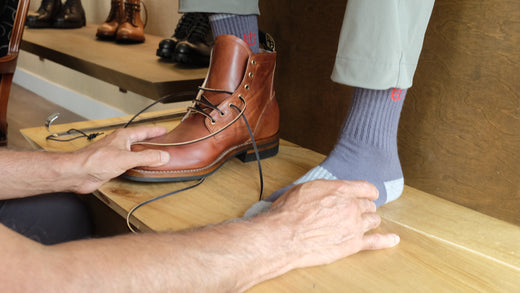How A Properly Fitted Shoe Should Feel and What You Should Look For When Trying On A Pair of Shoes
The fit on a pair of shoes is the most important aspect of purchasing footwear in our opinion. If you have the nicest looking pair of shoes and they don’t fit well, you won’t wear them. No pair of shoes -no matter how nice they look, no matter the quality of construction or quality of material is going to be worn if they are uncomfortable.
Whether you are buying classic dress shoes, work boots, athletic shoes or custom-made shoes; these are the 4 areas you need to be aware of when you are trying on a pair of shoes:
The widest part of your feet is at the ball of your foot, this means the widest part of the shoe should line up with the ball of your foot. This is the part of the shoe that will flex and bend, and if the shoe doesn’t match up with the ball of your foot, your shoe will be extremely uncomfortable to wear. When you are bending your foot as you walk, check that the crease is at the widest part of the shoe, not too close to the toe or too far up the vamp.
Toe box area: Your toes should have freedom to move in the toe box. Your toes should not pinch or bunch tightly together. Your toes should never touch the end of the toe box. When you walk, you push off with your toes; you want your toes to have mobility inside of the shoe in order comfortably walk or run.
Some people with wide feet will squish their toes into shoes; in addition to an uncomfortable fit, you could potentially damage the nerves in your toes if you continuously wear shoes that are not wide enough to accommodate this area.
Arch and In-Step: You want to feel like this part of your shoe is hugging the middle part of your foot. If this area is loose, you will not have proper stability and result in the insoles and lining wearing out faster and unevenly.
The fit in this area is especially important for a Chelsea boot because there aren’t any laces. Lace-up boots or running shoes are more forgiving as you can adjust the tightness around your arch and in-step with the lacing.
Counter/Heel: There should not be any big up and down movement of your heel in the back of the shoe. A new pair of shoes may actually have a little heel slip until they are broken in; we see this most often with engineer boots. **Tip: When shopping for leather shoes, try to find shoes or boots with a leather counter as opposed to celastic or cardboard. Leather counters built into the heel allows for the shoe or boot to conform to the shape and movement of your foot and will be more comfortable over time.
Your feet should not move forwards or backwards in a properly fitted shoe and they should feel snug in your shoes without being too tight. When your shoes fit correctly, you have more stability and will have less fatigue in your feet.
If you have a pair of shoes that is a tad too loose, you could try wearing thicker socks and adding an insole for a better fit. If you have a pair of leather shoes that is a tad too large, you could take this to a shoemaker or a cobbler for a complete recraft in order to make your shoe to the right size for you.


0 Comments
There are no comments for this article. Be the first one to leave a message!